MBA401: Reflective Journal on Contemporary Leadership and Culture
VerifiedAdded on 2023/04/21
|11
|3488
|163
Journal and Reflective Writing
AI Summary
This MBA401 reflective journal provides a comprehensive analysis of leadership, culture, and contemporary leadership theories, drawing upon personal experiences, online resources, and in-class activities. It delves into talent management, emphasizing the importance of effective channelization, talent acquisition, and human resource development. The journal also highlights the significance of communication in fostering trust and collaboration within teams, as well as the role of cultural management in promoting diversity and inclusion. Furthermore, it reflects on the impact of psychometric tests and feedback on leadership development, ultimately advocating for the contingency theory as a suitable framework for modern leadership, emphasizing adaptability and innovation. Desklib offers a platform for students to access this and many other solved assignments.
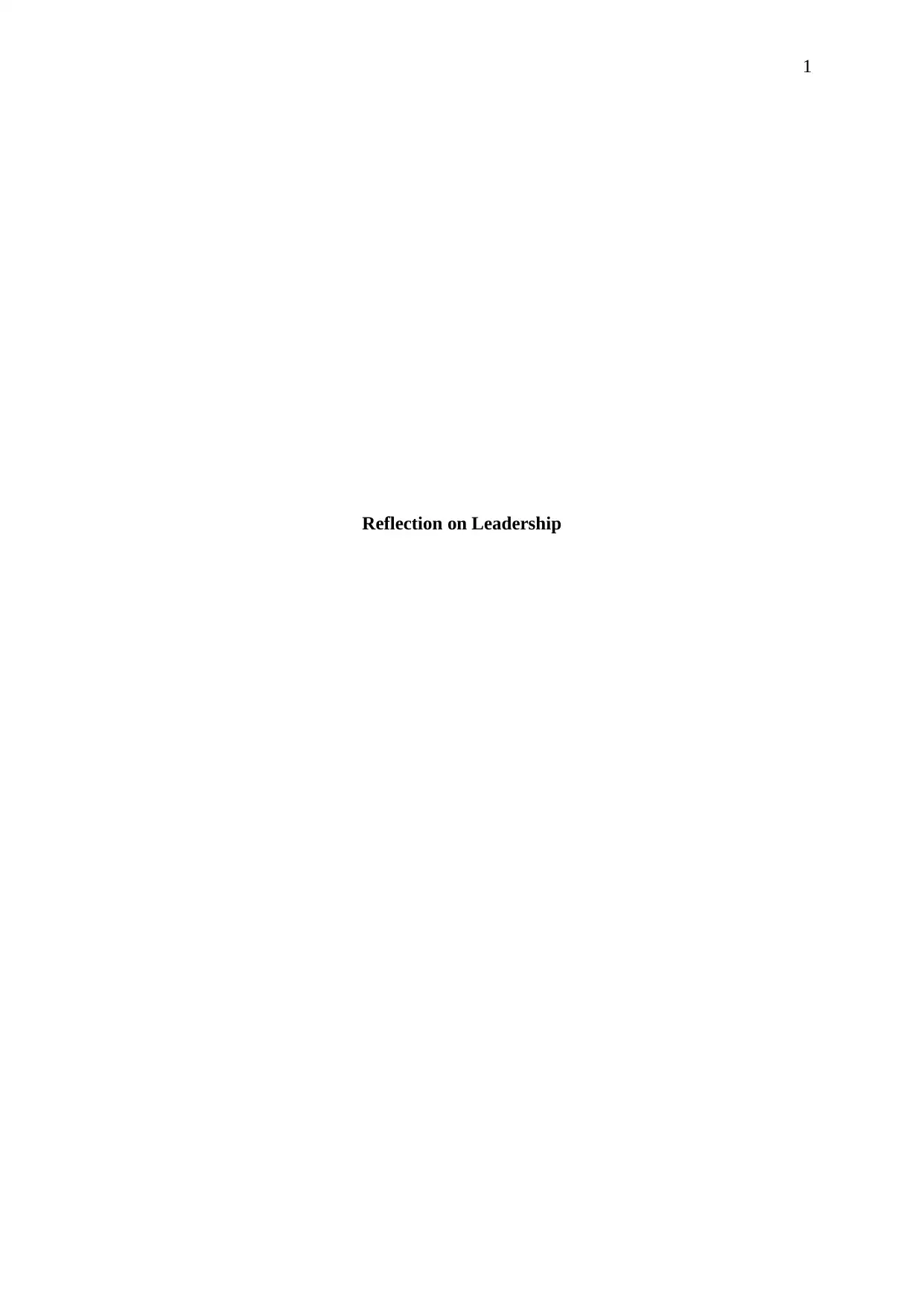
1
Reflection on Leadership
Reflection on Leadership
Paraphrase This Document
Need a fresh take? Get an instant paraphrase of this document with our AI Paraphraser
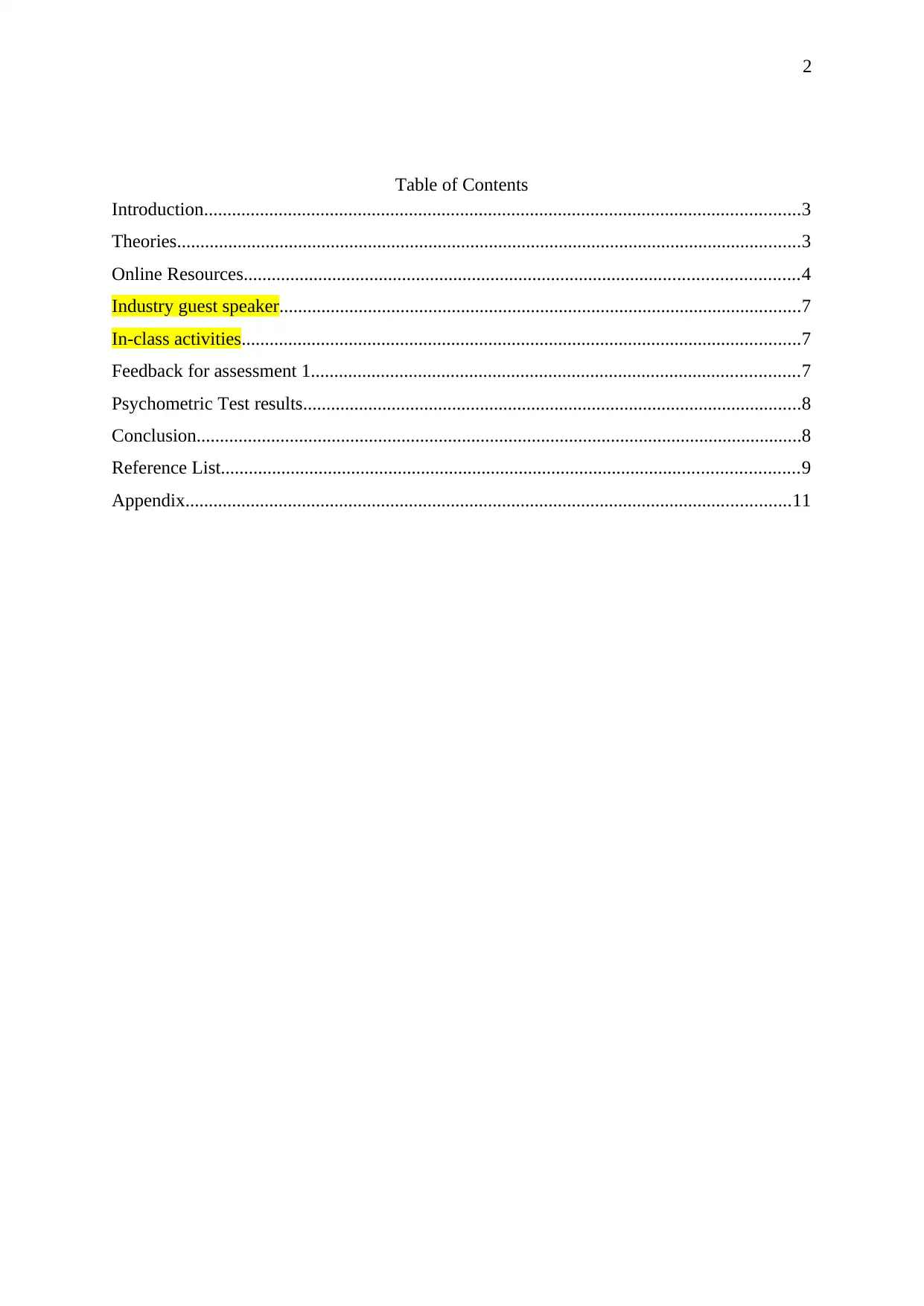
2
Table of Contents
Introduction................................................................................................................................3
Theories......................................................................................................................................3
Online Resources.......................................................................................................................4
Industry guest speaker................................................................................................................7
In-class activities........................................................................................................................7
Feedback for assessment 1.........................................................................................................7
Psychometric Test results...........................................................................................................8
Conclusion..................................................................................................................................8
Reference List............................................................................................................................9
Appendix..................................................................................................................................11
Table of Contents
Introduction................................................................................................................................3
Theories......................................................................................................................................3
Online Resources.......................................................................................................................4
Industry guest speaker................................................................................................................7
In-class activities........................................................................................................................7
Feedback for assessment 1.........................................................................................................7
Psychometric Test results...........................................................................................................8
Conclusion..................................................................................................................................8
Reference List............................................................................................................................9
Appendix..................................................................................................................................11
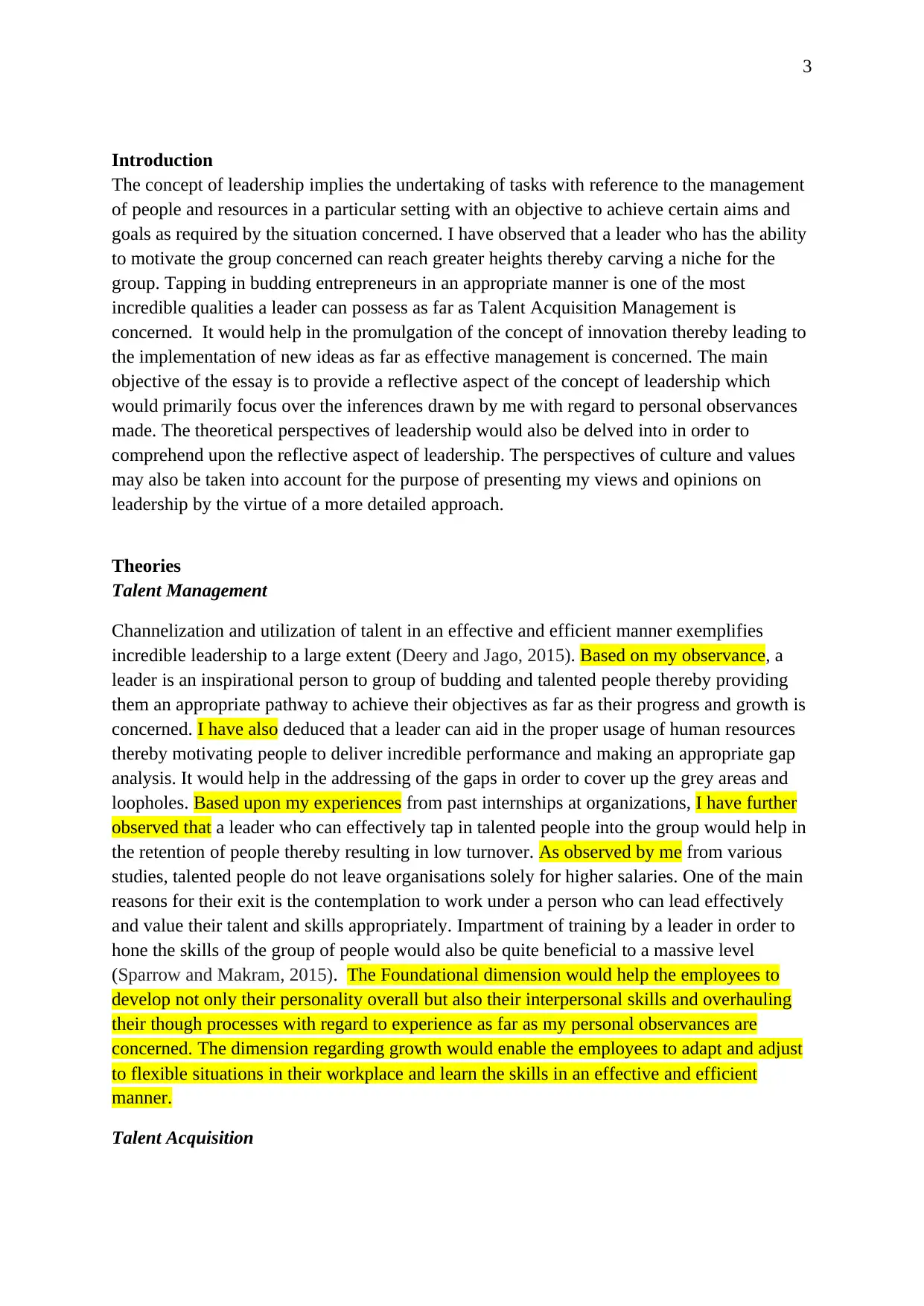
3
Introduction
The concept of leadership implies the undertaking of tasks with reference to the management
of people and resources in a particular setting with an objective to achieve certain aims and
goals as required by the situation concerned. I have observed that a leader who has the ability
to motivate the group concerned can reach greater heights thereby carving a niche for the
group. Tapping in budding entrepreneurs in an appropriate manner is one of the most
incredible qualities a leader can possess as far as Talent Acquisition Management is
concerned. It would help in the promulgation of the concept of innovation thereby leading to
the implementation of new ideas as far as effective management is concerned. The main
objective of the essay is to provide a reflective aspect of the concept of leadership which
would primarily focus over the inferences drawn by me with regard to personal observances
made. The theoretical perspectives of leadership would also be delved into in order to
comprehend upon the reflective aspect of leadership. The perspectives of culture and values
may also be taken into account for the purpose of presenting my views and opinions on
leadership by the virtue of a more detailed approach.
Theories
Talent Management
Channelization and utilization of talent in an effective and efficient manner exemplifies
incredible leadership to a large extent (Deery and Jago, 2015). Based on my observance, a
leader is an inspirational person to group of budding and talented people thereby providing
them an appropriate pathway to achieve their objectives as far as their progress and growth is
concerned. I have also deduced that a leader can aid in the proper usage of human resources
thereby motivating people to deliver incredible performance and making an appropriate gap
analysis. It would help in the addressing of the gaps in order to cover up the grey areas and
loopholes. Based upon my experiences from past internships at organizations, I have further
observed that a leader who can effectively tap in talented people into the group would help in
the retention of people thereby resulting in low turnover. As observed by me from various
studies, talented people do not leave organisations solely for higher salaries. One of the main
reasons for their exit is the contemplation to work under a person who can lead effectively
and value their talent and skills appropriately. Impartment of training by a leader in order to
hone the skills of the group of people would also be quite beneficial to a massive level
(Sparrow and Makram, 2015). The Foundational dimension would help the employees to
develop not only their personality overall but also their interpersonal skills and overhauling
their though processes with regard to experience as far as my personal observances are
concerned. The dimension regarding growth would enable the employees to adapt and adjust
to flexible situations in their workplace and learn the skills in an effective and efficient
manner.
Talent Acquisition
Introduction
The concept of leadership implies the undertaking of tasks with reference to the management
of people and resources in a particular setting with an objective to achieve certain aims and
goals as required by the situation concerned. I have observed that a leader who has the ability
to motivate the group concerned can reach greater heights thereby carving a niche for the
group. Tapping in budding entrepreneurs in an appropriate manner is one of the most
incredible qualities a leader can possess as far as Talent Acquisition Management is
concerned. It would help in the promulgation of the concept of innovation thereby leading to
the implementation of new ideas as far as effective management is concerned. The main
objective of the essay is to provide a reflective aspect of the concept of leadership which
would primarily focus over the inferences drawn by me with regard to personal observances
made. The theoretical perspectives of leadership would also be delved into in order to
comprehend upon the reflective aspect of leadership. The perspectives of culture and values
may also be taken into account for the purpose of presenting my views and opinions on
leadership by the virtue of a more detailed approach.
Theories
Talent Management
Channelization and utilization of talent in an effective and efficient manner exemplifies
incredible leadership to a large extent (Deery and Jago, 2015). Based on my observance, a
leader is an inspirational person to group of budding and talented people thereby providing
them an appropriate pathway to achieve their objectives as far as their progress and growth is
concerned. I have also deduced that a leader can aid in the proper usage of human resources
thereby motivating people to deliver incredible performance and making an appropriate gap
analysis. It would help in the addressing of the gaps in order to cover up the grey areas and
loopholes. Based upon my experiences from past internships at organizations, I have further
observed that a leader who can effectively tap in talented people into the group would help in
the retention of people thereby resulting in low turnover. As observed by me from various
studies, talented people do not leave organisations solely for higher salaries. One of the main
reasons for their exit is the contemplation to work under a person who can lead effectively
and value their talent and skills appropriately. Impartment of training by a leader in order to
hone the skills of the group of people would also be quite beneficial to a massive level
(Sparrow and Makram, 2015). The Foundational dimension would help the employees to
develop not only their personality overall but also their interpersonal skills and overhauling
their though processes with regard to experience as far as my personal observances are
concerned. The dimension regarding growth would enable the employees to adapt and adjust
to flexible situations in their workplace and learn the skills in an effective and efficient
manner.
Talent Acquisition
⊘ This is a preview!⊘
Do you want full access?
Subscribe today to unlock all pages.

Trusted by 1+ million students worldwide
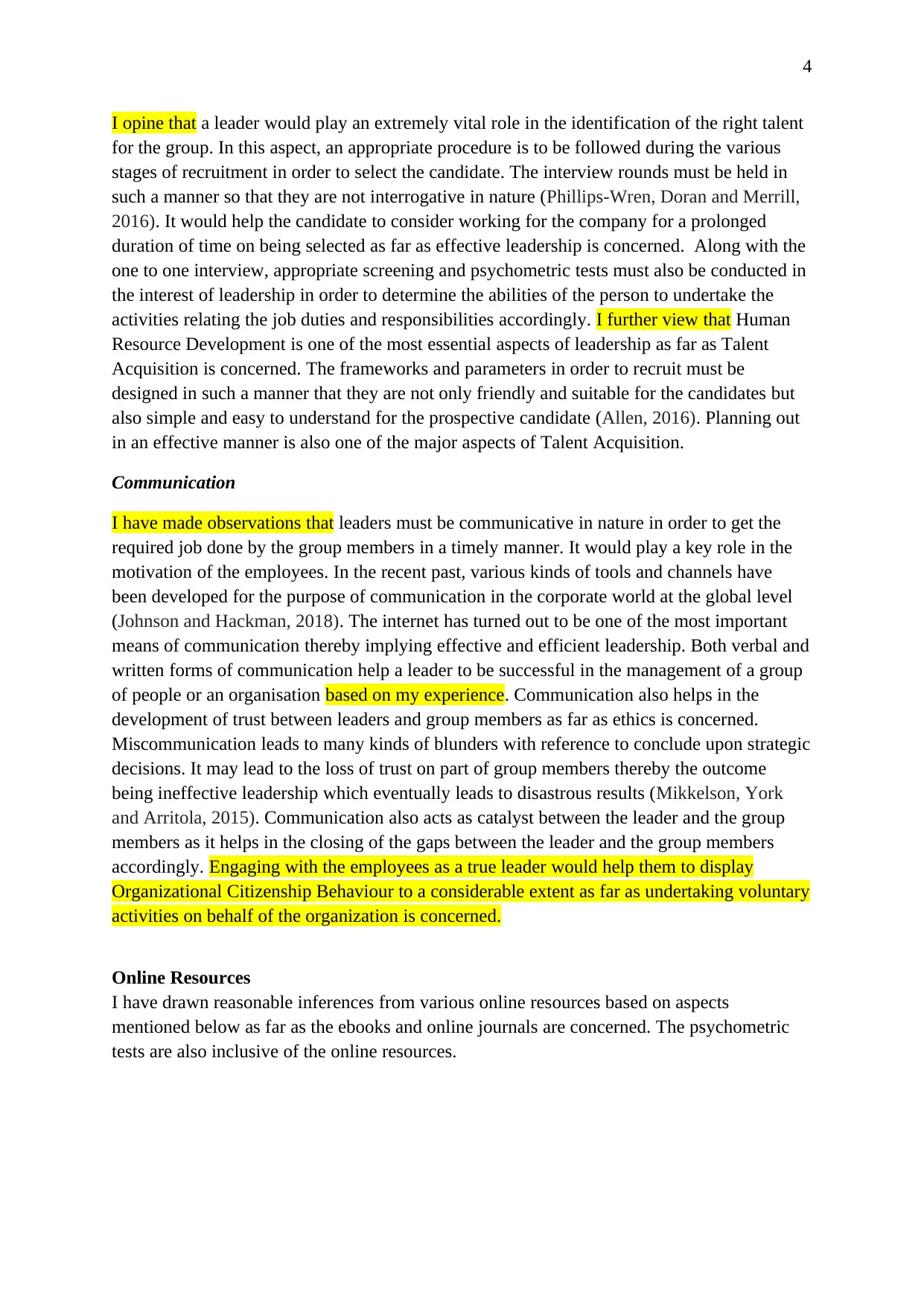
4
I opine that a leader would play an extremely vital role in the identification of the right talent
for the group. In this aspect, an appropriate procedure is to be followed during the various
stages of recruitment in order to select the candidate. The interview rounds must be held in
such a manner so that they are not interrogative in nature (Phillips-Wren, Doran and Merrill,
2016). It would help the candidate to consider working for the company for a prolonged
duration of time on being selected as far as effective leadership is concerned. Along with the
one to one interview, appropriate screening and psychometric tests must also be conducted in
the interest of leadership in order to determine the abilities of the person to undertake the
activities relating the job duties and responsibilities accordingly. I further view that Human
Resource Development is one of the most essential aspects of leadership as far as Talent
Acquisition is concerned. The frameworks and parameters in order to recruit must be
designed in such a manner that they are not only friendly and suitable for the candidates but
also simple and easy to understand for the prospective candidate (Allen, 2016). Planning out
in an effective manner is also one of the major aspects of Talent Acquisition.
Communication
I have made observations that leaders must be communicative in nature in order to get the
required job done by the group members in a timely manner. It would play a key role in the
motivation of the employees. In the recent past, various kinds of tools and channels have
been developed for the purpose of communication in the corporate world at the global level
(Johnson and Hackman, 2018). The internet has turned out to be one of the most important
means of communication thereby implying effective and efficient leadership. Both verbal and
written forms of communication help a leader to be successful in the management of a group
of people or an organisation based on my experience. Communication also helps in the
development of trust between leaders and group members as far as ethics is concerned.
Miscommunication leads to many kinds of blunders with reference to conclude upon strategic
decisions. It may lead to the loss of trust on part of group members thereby the outcome
being ineffective leadership which eventually leads to disastrous results (Mikkelson, York
and Arritola, 2015). Communication also acts as catalyst between the leader and the group
members as it helps in the closing of the gaps between the leader and the group members
accordingly. Engaging with the employees as a true leader would help them to display
Organizational Citizenship Behaviour to a considerable extent as far as undertaking voluntary
activities on behalf of the organization is concerned.
Online Resources
I have drawn reasonable inferences from various online resources based on aspects
mentioned below as far as the ebooks and online journals are concerned. The psychometric
tests are also inclusive of the online resources.
I opine that a leader would play an extremely vital role in the identification of the right talent
for the group. In this aspect, an appropriate procedure is to be followed during the various
stages of recruitment in order to select the candidate. The interview rounds must be held in
such a manner so that they are not interrogative in nature (Phillips-Wren, Doran and Merrill,
2016). It would help the candidate to consider working for the company for a prolonged
duration of time on being selected as far as effective leadership is concerned. Along with the
one to one interview, appropriate screening and psychometric tests must also be conducted in
the interest of leadership in order to determine the abilities of the person to undertake the
activities relating the job duties and responsibilities accordingly. I further view that Human
Resource Development is one of the most essential aspects of leadership as far as Talent
Acquisition is concerned. The frameworks and parameters in order to recruit must be
designed in such a manner that they are not only friendly and suitable for the candidates but
also simple and easy to understand for the prospective candidate (Allen, 2016). Planning out
in an effective manner is also one of the major aspects of Talent Acquisition.
Communication
I have made observations that leaders must be communicative in nature in order to get the
required job done by the group members in a timely manner. It would play a key role in the
motivation of the employees. In the recent past, various kinds of tools and channels have
been developed for the purpose of communication in the corporate world at the global level
(Johnson and Hackman, 2018). The internet has turned out to be one of the most important
means of communication thereby implying effective and efficient leadership. Both verbal and
written forms of communication help a leader to be successful in the management of a group
of people or an organisation based on my experience. Communication also helps in the
development of trust between leaders and group members as far as ethics is concerned.
Miscommunication leads to many kinds of blunders with reference to conclude upon strategic
decisions. It may lead to the loss of trust on part of group members thereby the outcome
being ineffective leadership which eventually leads to disastrous results (Mikkelson, York
and Arritola, 2015). Communication also acts as catalyst between the leader and the group
members as it helps in the closing of the gaps between the leader and the group members
accordingly. Engaging with the employees as a true leader would help them to display
Organizational Citizenship Behaviour to a considerable extent as far as undertaking voluntary
activities on behalf of the organization is concerned.
Online Resources
I have drawn reasonable inferences from various online resources based on aspects
mentioned below as far as the ebooks and online journals are concerned. The psychometric
tests are also inclusive of the online resources.
Paraphrase This Document
Need a fresh take? Get an instant paraphrase of this document with our AI Paraphraser
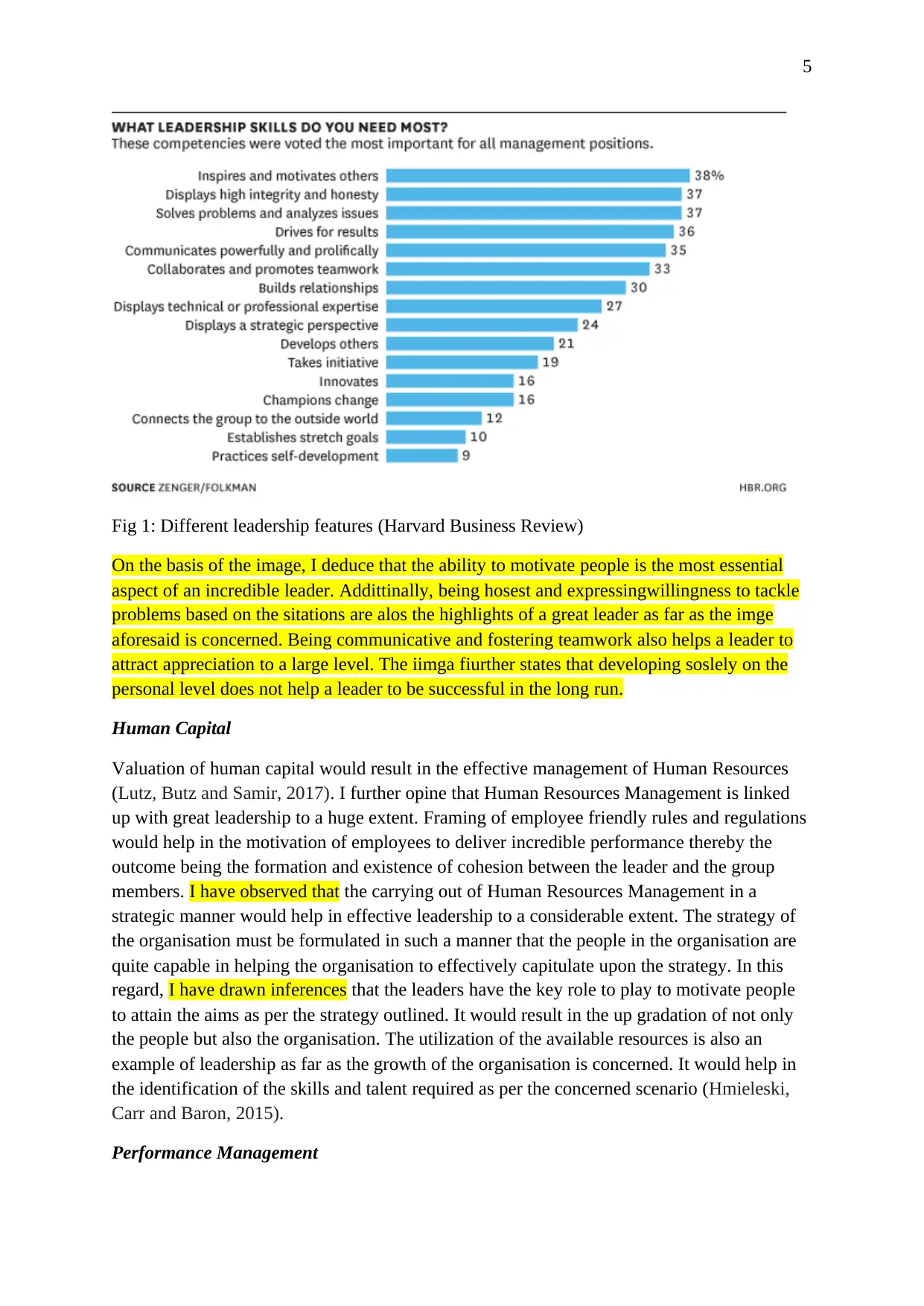
5
Fig 1: Different leadership features (Harvard Business Review)
On the basis of the image, I deduce that the ability to motivate people is the most essential
aspect of an incredible leader. Addittinally, being hosest and expressingwillingness to tackle
problems based on the sitations are alos the highlights of a great leader as far as the imge
aforesaid is concerned. Being communicative and fostering teamwork also helps a leader to
attract appreciation to a large level. The iimga fiurther states that developing soslely on the
personal level does not help a leader to be successful in the long run.
Human Capital
Valuation of human capital would result in the effective management of Human Resources
(Lutz, Butz and Samir, 2017). I further opine that Human Resources Management is linked
up with great leadership to a huge extent. Framing of employee friendly rules and regulations
would help in the motivation of employees to deliver incredible performance thereby the
outcome being the formation and existence of cohesion between the leader and the group
members. I have observed that the carrying out of Human Resources Management in a
strategic manner would help in effective leadership to a considerable extent. The strategy of
the organisation must be formulated in such a manner that the people in the organisation are
quite capable in helping the organisation to effectively capitulate upon the strategy. In this
regard, I have drawn inferences that the leaders have the key role to play to motivate people
to attain the aims as per the strategy outlined. It would result in the up gradation of not only
the people but also the organisation. The utilization of the available resources is also an
example of leadership as far as the growth of the organisation is concerned. It would help in
the identification of the skills and talent required as per the concerned scenario (Hmieleski,
Carr and Baron, 2015).
Performance Management
Fig 1: Different leadership features (Harvard Business Review)
On the basis of the image, I deduce that the ability to motivate people is the most essential
aspect of an incredible leader. Addittinally, being hosest and expressingwillingness to tackle
problems based on the sitations are alos the highlights of a great leader as far as the imge
aforesaid is concerned. Being communicative and fostering teamwork also helps a leader to
attract appreciation to a large level. The iimga fiurther states that developing soslely on the
personal level does not help a leader to be successful in the long run.
Human Capital
Valuation of human capital would result in the effective management of Human Resources
(Lutz, Butz and Samir, 2017). I further opine that Human Resources Management is linked
up with great leadership to a huge extent. Framing of employee friendly rules and regulations
would help in the motivation of employees to deliver incredible performance thereby the
outcome being the formation and existence of cohesion between the leader and the group
members. I have observed that the carrying out of Human Resources Management in a
strategic manner would help in effective leadership to a considerable extent. The strategy of
the organisation must be formulated in such a manner that the people in the organisation are
quite capable in helping the organisation to effectively capitulate upon the strategy. In this
regard, I have drawn inferences that the leaders have the key role to play to motivate people
to attain the aims as per the strategy outlined. It would result in the up gradation of not only
the people but also the organisation. The utilization of the available resources is also an
example of leadership as far as the growth of the organisation is concerned. It would help in
the identification of the skills and talent required as per the concerned scenario (Hmieleski,
Carr and Baron, 2015).
Performance Management
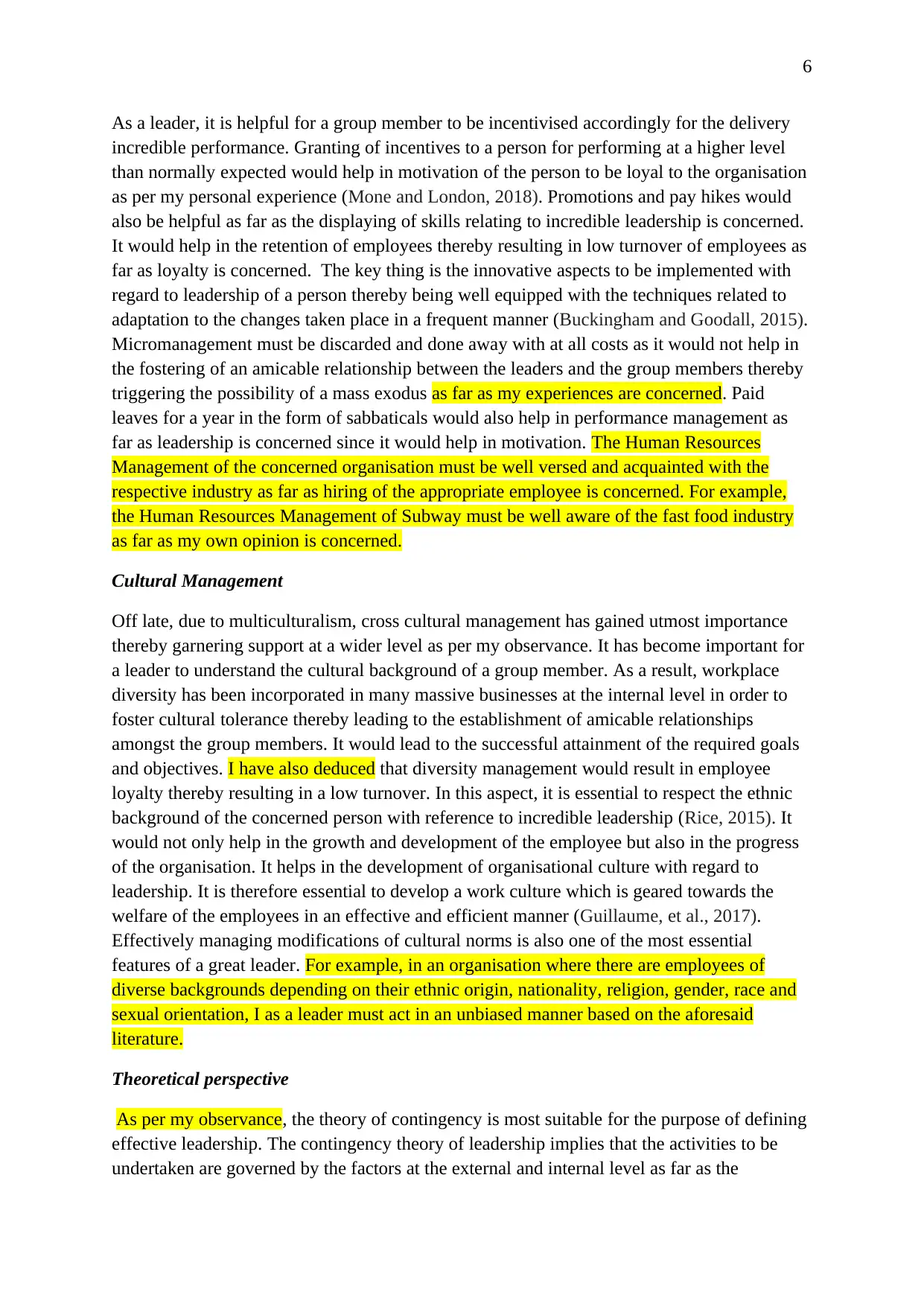
6
As a leader, it is helpful for a group member to be incentivised accordingly for the delivery
incredible performance. Granting of incentives to a person for performing at a higher level
than normally expected would help in motivation of the person to be loyal to the organisation
as per my personal experience (Mone and London, 2018). Promotions and pay hikes would
also be helpful as far as the displaying of skills relating to incredible leadership is concerned.
It would help in the retention of employees thereby resulting in low turnover of employees as
far as loyalty is concerned. The key thing is the innovative aspects to be implemented with
regard to leadership of a person thereby being well equipped with the techniques related to
adaptation to the changes taken place in a frequent manner (Buckingham and Goodall, 2015).
Micromanagement must be discarded and done away with at all costs as it would not help in
the fostering of an amicable relationship between the leaders and the group members thereby
triggering the possibility of a mass exodus as far as my experiences are concerned. Paid
leaves for a year in the form of sabbaticals would also help in performance management as
far as leadership is concerned since it would help in motivation. The Human Resources
Management of the concerned organisation must be well versed and acquainted with the
respective industry as far as hiring of the appropriate employee is concerned. For example,
the Human Resources Management of Subway must be well aware of the fast food industry
as far as my own opinion is concerned.
Cultural Management
Off late, due to multiculturalism, cross cultural management has gained utmost importance
thereby garnering support at a wider level as per my observance. It has become important for
a leader to understand the cultural background of a group member. As a result, workplace
diversity has been incorporated in many massive businesses at the internal level in order to
foster cultural tolerance thereby leading to the establishment of amicable relationships
amongst the group members. It would lead to the successful attainment of the required goals
and objectives. I have also deduced that diversity management would result in employee
loyalty thereby resulting in a low turnover. In this aspect, it is essential to respect the ethnic
background of the concerned person with reference to incredible leadership (Rice, 2015). It
would not only help in the growth and development of the employee but also in the progress
of the organisation. It helps in the development of organisational culture with regard to
leadership. It is therefore essential to develop a work culture which is geared towards the
welfare of the employees in an effective and efficient manner (Guillaume, et al., 2017).
Effectively managing modifications of cultural norms is also one of the most essential
features of a great leader. For example, in an organisation where there are employees of
diverse backgrounds depending on their ethnic origin, nationality, religion, gender, race and
sexual orientation, I as a leader must act in an unbiased manner based on the aforesaid
literature.
Theoretical perspective
As per my observance, the theory of contingency is most suitable for the purpose of defining
effective leadership. The contingency theory of leadership implies that the activities to be
undertaken are governed by the factors at the external and internal level as far as the
As a leader, it is helpful for a group member to be incentivised accordingly for the delivery
incredible performance. Granting of incentives to a person for performing at a higher level
than normally expected would help in motivation of the person to be loyal to the organisation
as per my personal experience (Mone and London, 2018). Promotions and pay hikes would
also be helpful as far as the displaying of skills relating to incredible leadership is concerned.
It would help in the retention of employees thereby resulting in low turnover of employees as
far as loyalty is concerned. The key thing is the innovative aspects to be implemented with
regard to leadership of a person thereby being well equipped with the techniques related to
adaptation to the changes taken place in a frequent manner (Buckingham and Goodall, 2015).
Micromanagement must be discarded and done away with at all costs as it would not help in
the fostering of an amicable relationship between the leaders and the group members thereby
triggering the possibility of a mass exodus as far as my experiences are concerned. Paid
leaves for a year in the form of sabbaticals would also help in performance management as
far as leadership is concerned since it would help in motivation. The Human Resources
Management of the concerned organisation must be well versed and acquainted with the
respective industry as far as hiring of the appropriate employee is concerned. For example,
the Human Resources Management of Subway must be well aware of the fast food industry
as far as my own opinion is concerned.
Cultural Management
Off late, due to multiculturalism, cross cultural management has gained utmost importance
thereby garnering support at a wider level as per my observance. It has become important for
a leader to understand the cultural background of a group member. As a result, workplace
diversity has been incorporated in many massive businesses at the internal level in order to
foster cultural tolerance thereby leading to the establishment of amicable relationships
amongst the group members. It would lead to the successful attainment of the required goals
and objectives. I have also deduced that diversity management would result in employee
loyalty thereby resulting in a low turnover. In this aspect, it is essential to respect the ethnic
background of the concerned person with reference to incredible leadership (Rice, 2015). It
would not only help in the growth and development of the employee but also in the progress
of the organisation. It helps in the development of organisational culture with regard to
leadership. It is therefore essential to develop a work culture which is geared towards the
welfare of the employees in an effective and efficient manner (Guillaume, et al., 2017).
Effectively managing modifications of cultural norms is also one of the most essential
features of a great leader. For example, in an organisation where there are employees of
diverse backgrounds depending on their ethnic origin, nationality, religion, gender, race and
sexual orientation, I as a leader must act in an unbiased manner based on the aforesaid
literature.
Theoretical perspective
As per my observance, the theory of contingency is most suitable for the purpose of defining
effective leadership. The contingency theory of leadership implies that the activities to be
undertaken are governed by the factors at the external and internal level as far as the
⊘ This is a preview!⊘
Do you want full access?
Subscribe today to unlock all pages.

Trusted by 1+ million students worldwide
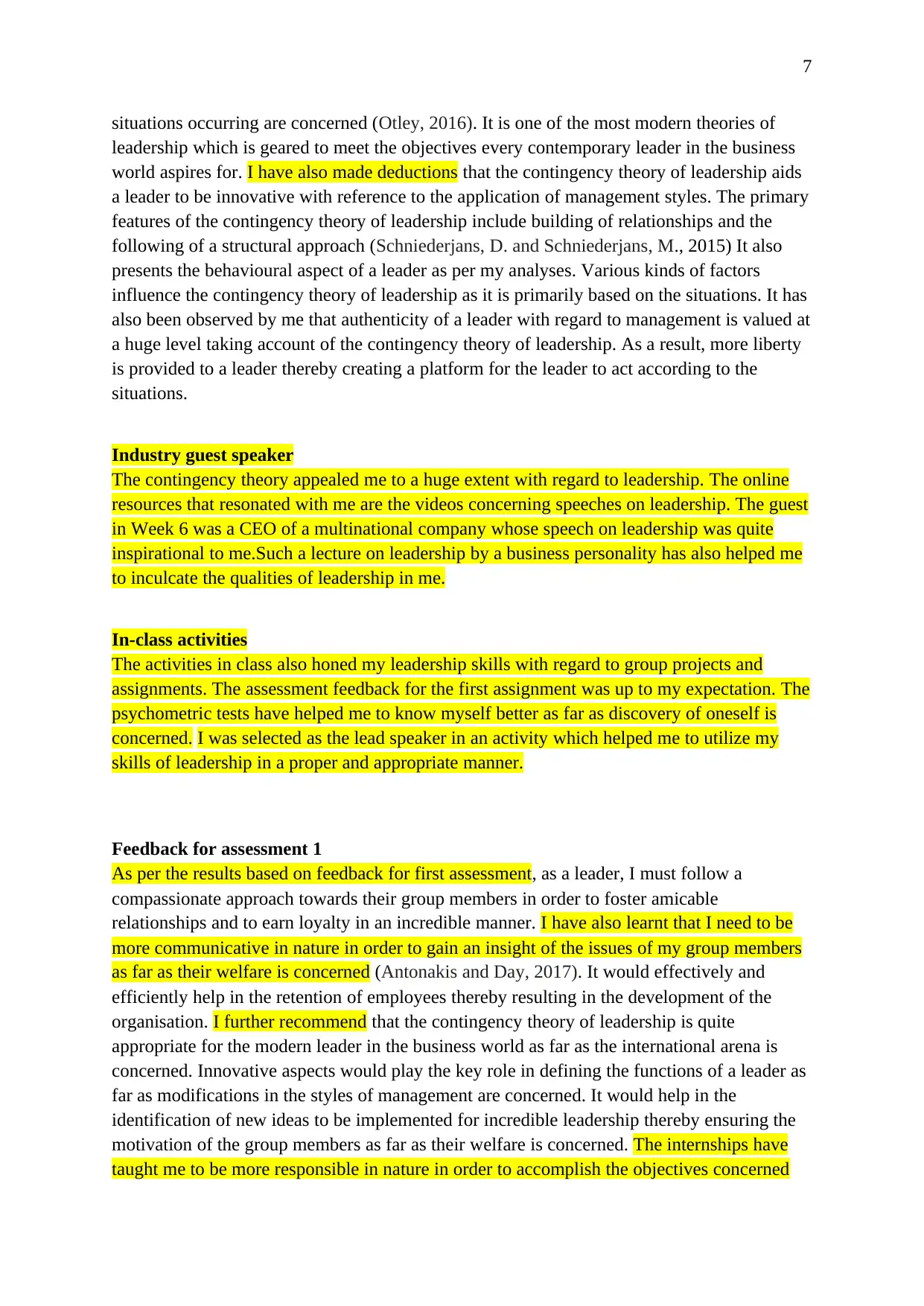
7
situations occurring are concerned (Otley, 2016). It is one of the most modern theories of
leadership which is geared to meet the objectives every contemporary leader in the business
world aspires for. I have also made deductions that the contingency theory of leadership aids
a leader to be innovative with reference to the application of management styles. The primary
features of the contingency theory of leadership include building of relationships and the
following of a structural approach (Schniederjans, D. and Schniederjans, M., 2015) It also
presents the behavioural aspect of a leader as per my analyses. Various kinds of factors
influence the contingency theory of leadership as it is primarily based on the situations. It has
also been observed by me that authenticity of a leader with regard to management is valued at
a huge level taking account of the contingency theory of leadership. As a result, more liberty
is provided to a leader thereby creating a platform for the leader to act according to the
situations.
Industry guest speaker
The contingency theory appealed me to a huge extent with regard to leadership. The online
resources that resonated with me are the videos concerning speeches on leadership. The guest
in Week 6 was a CEO of a multinational company whose speech on leadership was quite
inspirational to me.Such a lecture on leadership by a business personality has also helped me
to inculcate the qualities of leadership in me.
In-class activities
The activities in class also honed my leadership skills with regard to group projects and
assignments. The assessment feedback for the first assignment was up to my expectation. The
psychometric tests have helped me to know myself better as far as discovery of oneself is
concerned. I was selected as the lead speaker in an activity which helped me to utilize my
skills of leadership in a proper and appropriate manner.
Feedback for assessment 1
As per the results based on feedback for first assessment, as a leader, I must follow a
compassionate approach towards their group members in order to foster amicable
relationships and to earn loyalty in an incredible manner. I have also learnt that I need to be
more communicative in nature in order to gain an insight of the issues of my group members
as far as their welfare is concerned (Antonakis and Day, 2017). It would effectively and
efficiently help in the retention of employees thereby resulting in the development of the
organisation. I further recommend that the contingency theory of leadership is quite
appropriate for the modern leader in the business world as far as the international arena is
concerned. Innovative aspects would play the key role in defining the functions of a leader as
far as modifications in the styles of management are concerned. It would help in the
identification of new ideas to be implemented for incredible leadership thereby ensuring the
motivation of the group members as far as their welfare is concerned. The internships have
taught me to be more responsible in nature in order to accomplish the objectives concerned
situations occurring are concerned (Otley, 2016). It is one of the most modern theories of
leadership which is geared to meet the objectives every contemporary leader in the business
world aspires for. I have also made deductions that the contingency theory of leadership aids
a leader to be innovative with reference to the application of management styles. The primary
features of the contingency theory of leadership include building of relationships and the
following of a structural approach (Schniederjans, D. and Schniederjans, M., 2015) It also
presents the behavioural aspect of a leader as per my analyses. Various kinds of factors
influence the contingency theory of leadership as it is primarily based on the situations. It has
also been observed by me that authenticity of a leader with regard to management is valued at
a huge level taking account of the contingency theory of leadership. As a result, more liberty
is provided to a leader thereby creating a platform for the leader to act according to the
situations.
Industry guest speaker
The contingency theory appealed me to a huge extent with regard to leadership. The online
resources that resonated with me are the videos concerning speeches on leadership. The guest
in Week 6 was a CEO of a multinational company whose speech on leadership was quite
inspirational to me.Such a lecture on leadership by a business personality has also helped me
to inculcate the qualities of leadership in me.
In-class activities
The activities in class also honed my leadership skills with regard to group projects and
assignments. The assessment feedback for the first assignment was up to my expectation. The
psychometric tests have helped me to know myself better as far as discovery of oneself is
concerned. I was selected as the lead speaker in an activity which helped me to utilize my
skills of leadership in a proper and appropriate manner.
Feedback for assessment 1
As per the results based on feedback for first assessment, as a leader, I must follow a
compassionate approach towards their group members in order to foster amicable
relationships and to earn loyalty in an incredible manner. I have also learnt that I need to be
more communicative in nature in order to gain an insight of the issues of my group members
as far as their welfare is concerned (Antonakis and Day, 2017). It would effectively and
efficiently help in the retention of employees thereby resulting in the development of the
organisation. I further recommend that the contingency theory of leadership is quite
appropriate for the modern leader in the business world as far as the international arena is
concerned. Innovative aspects would play the key role in defining the functions of a leader as
far as modifications in the styles of management are concerned. It would help in the
identification of new ideas to be implemented for incredible leadership thereby ensuring the
motivation of the group members as far as their welfare is concerned. The internships have
taught me to be more responsible in nature in order to accomplish the objectives concerned
Paraphrase This Document
Need a fresh take? Get an instant paraphrase of this document with our AI Paraphraser
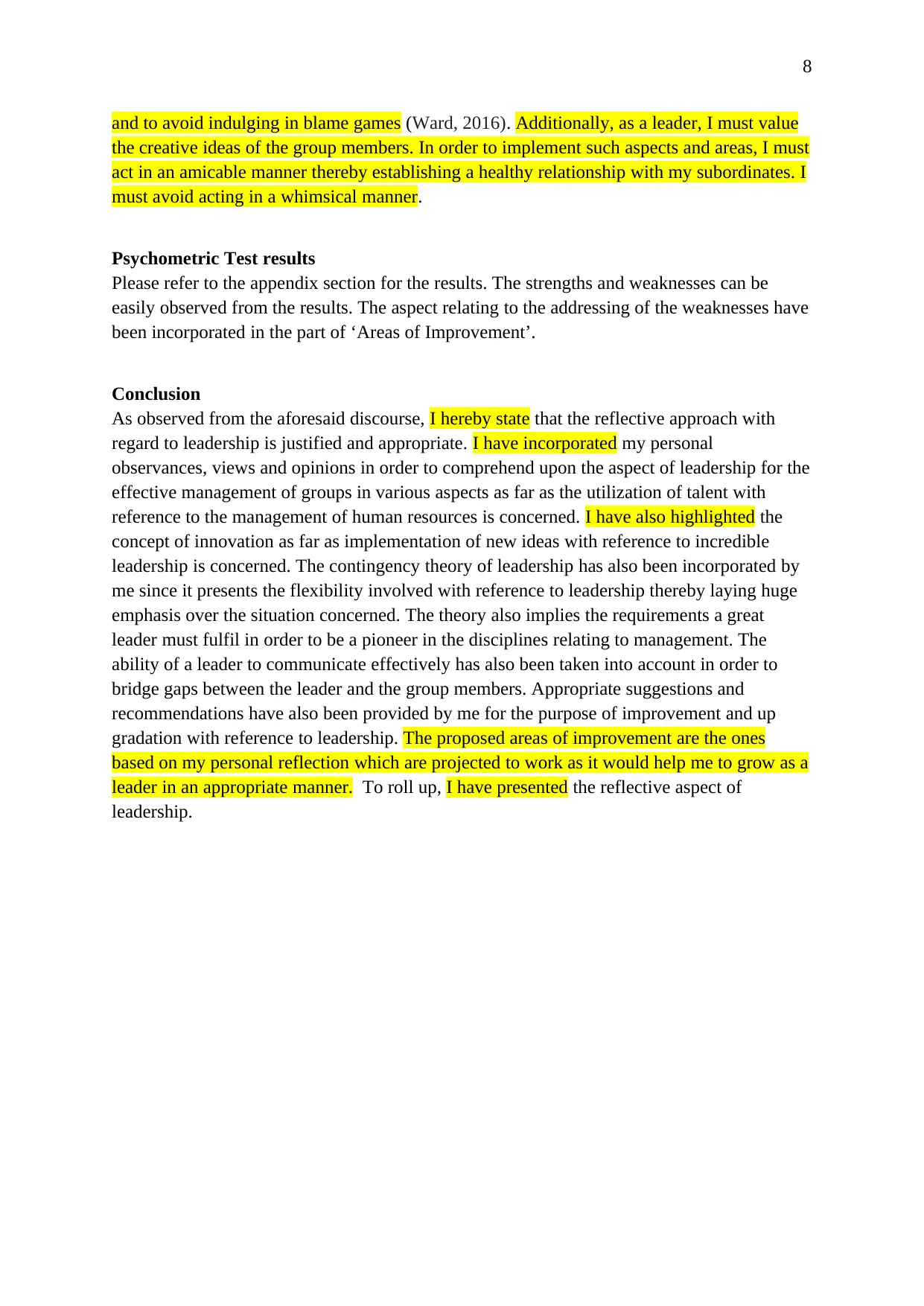
8
and to avoid indulging in blame games (Ward, 2016). Additionally, as a leader, I must value
the creative ideas of the group members. In order to implement such aspects and areas, I must
act in an amicable manner thereby establishing a healthy relationship with my subordinates. I
must avoid acting in a whimsical manner.
Psychometric Test results
Please refer to the appendix section for the results. The strengths and weaknesses can be
easily observed from the results. The aspect relating to the addressing of the weaknesses have
been incorporated in the part of ‘Areas of Improvement’.
Conclusion
As observed from the aforesaid discourse, I hereby state that the reflective approach with
regard to leadership is justified and appropriate. I have incorporated my personal
observances, views and opinions in order to comprehend upon the aspect of leadership for the
effective management of groups in various aspects as far as the utilization of talent with
reference to the management of human resources is concerned. I have also highlighted the
concept of innovation as far as implementation of new ideas with reference to incredible
leadership is concerned. The contingency theory of leadership has also been incorporated by
me since it presents the flexibility involved with reference to leadership thereby laying huge
emphasis over the situation concerned. The theory also implies the requirements a great
leader must fulfil in order to be a pioneer in the disciplines relating to management. The
ability of a leader to communicate effectively has also been taken into account in order to
bridge gaps between the leader and the group members. Appropriate suggestions and
recommendations have also been provided by me for the purpose of improvement and up
gradation with reference to leadership. The proposed areas of improvement are the ones
based on my personal reflection which are projected to work as it would help me to grow as a
leader in an appropriate manner. To roll up, I have presented the reflective aspect of
leadership.
and to avoid indulging in blame games (Ward, 2016). Additionally, as a leader, I must value
the creative ideas of the group members. In order to implement such aspects and areas, I must
act in an amicable manner thereby establishing a healthy relationship with my subordinates. I
must avoid acting in a whimsical manner.
Psychometric Test results
Please refer to the appendix section for the results. The strengths and weaknesses can be
easily observed from the results. The aspect relating to the addressing of the weaknesses have
been incorporated in the part of ‘Areas of Improvement’.
Conclusion
As observed from the aforesaid discourse, I hereby state that the reflective approach with
regard to leadership is justified and appropriate. I have incorporated my personal
observances, views and opinions in order to comprehend upon the aspect of leadership for the
effective management of groups in various aspects as far as the utilization of talent with
reference to the management of human resources is concerned. I have also highlighted the
concept of innovation as far as implementation of new ideas with reference to incredible
leadership is concerned. The contingency theory of leadership has also been incorporated by
me since it presents the flexibility involved with reference to leadership thereby laying huge
emphasis over the situation concerned. The theory also implies the requirements a great
leader must fulfil in order to be a pioneer in the disciplines relating to management. The
ability of a leader to communicate effectively has also been taken into account in order to
bridge gaps between the leader and the group members. Appropriate suggestions and
recommendations have also been provided by me for the purpose of improvement and up
gradation with reference to leadership. The proposed areas of improvement are the ones
based on my personal reflection which are projected to work as it would help me to grow as a
leader in an appropriate manner. To roll up, I have presented the reflective aspect of
leadership.
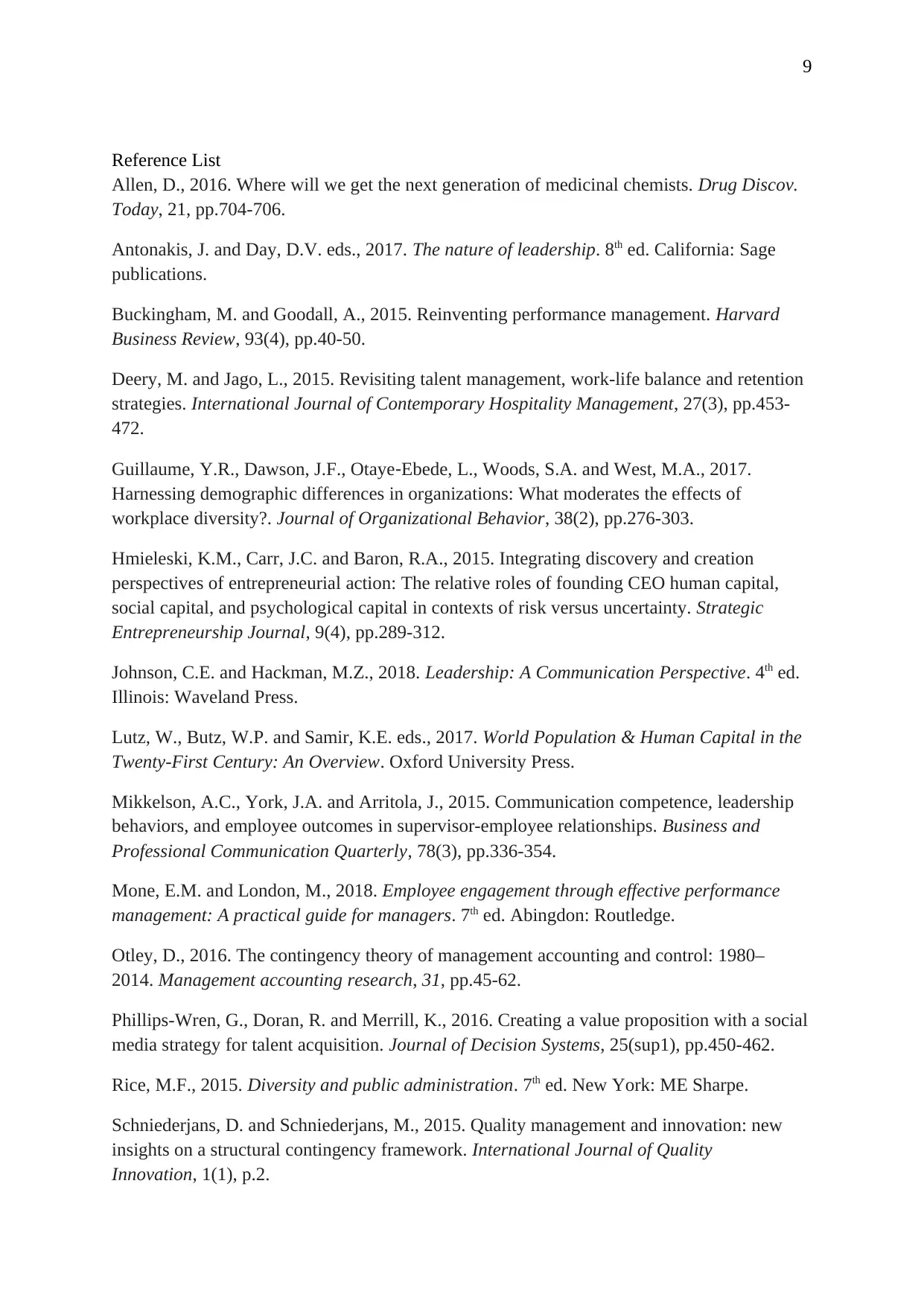
9
Reference List
Allen, D., 2016. Where will we get the next generation of medicinal chemists. Drug Discov.
Today, 21, pp.704-706.
Antonakis, J. and Day, D.V. eds., 2017. The nature of leadership. 8th ed. California: Sage
publications.
Buckingham, M. and Goodall, A., 2015. Reinventing performance management. Harvard
Business Review, 93(4), pp.40-50.
Deery, M. and Jago, L., 2015. Revisiting talent management, work-life balance and retention
strategies. International Journal of Contemporary Hospitality Management, 27(3), pp.453-
472.
Guillaume, Y.R., Dawson, J.F., Otaye‐Ebede, L., Woods, S.A. and West, M.A., 2017.
Harnessing demographic differences in organizations: What moderates the effects of
workplace diversity?. Journal of Organizational Behavior, 38(2), pp.276-303.
Hmieleski, K.M., Carr, J.C. and Baron, R.A., 2015. Integrating discovery and creation
perspectives of entrepreneurial action: The relative roles of founding CEO human capital,
social capital, and psychological capital in contexts of risk versus uncertainty. Strategic
Entrepreneurship Journal, 9(4), pp.289-312.
Johnson, C.E. and Hackman, M.Z., 2018. Leadership: A Communication Perspective. 4th ed.
Illinois: Waveland Press.
Lutz, W., Butz, W.P. and Samir, K.E. eds., 2017. World Population & Human Capital in the
Twenty-First Century: An Overview. Oxford University Press.
Mikkelson, A.C., York, J.A. and Arritola, J., 2015. Communication competence, leadership
behaviors, and employee outcomes in supervisor-employee relationships. Business and
Professional Communication Quarterly, 78(3), pp.336-354.
Mone, E.M. and London, M., 2018. Employee engagement through effective performance
management: A practical guide for managers. 7th ed. Abingdon: Routledge.
Otley, D., 2016. The contingency theory of management accounting and control: 1980–
2014. Management accounting research, 31, pp.45-62.
Phillips-Wren, G., Doran, R. and Merrill, K., 2016. Creating a value proposition with a social
media strategy for talent acquisition. Journal of Decision Systems, 25(sup1), pp.450-462.
Rice, M.F., 2015. Diversity and public administration. 7th ed. New York: ME Sharpe.
Schniederjans, D. and Schniederjans, M., 2015. Quality management and innovation: new
insights on a structural contingency framework. International Journal of Quality
Innovation, 1(1), p.2.
Reference List
Allen, D., 2016. Where will we get the next generation of medicinal chemists. Drug Discov.
Today, 21, pp.704-706.
Antonakis, J. and Day, D.V. eds., 2017. The nature of leadership. 8th ed. California: Sage
publications.
Buckingham, M. and Goodall, A., 2015. Reinventing performance management. Harvard
Business Review, 93(4), pp.40-50.
Deery, M. and Jago, L., 2015. Revisiting talent management, work-life balance and retention
strategies. International Journal of Contemporary Hospitality Management, 27(3), pp.453-
472.
Guillaume, Y.R., Dawson, J.F., Otaye‐Ebede, L., Woods, S.A. and West, M.A., 2017.
Harnessing demographic differences in organizations: What moderates the effects of
workplace diversity?. Journal of Organizational Behavior, 38(2), pp.276-303.
Hmieleski, K.M., Carr, J.C. and Baron, R.A., 2015. Integrating discovery and creation
perspectives of entrepreneurial action: The relative roles of founding CEO human capital,
social capital, and psychological capital in contexts of risk versus uncertainty. Strategic
Entrepreneurship Journal, 9(4), pp.289-312.
Johnson, C.E. and Hackman, M.Z., 2018. Leadership: A Communication Perspective. 4th ed.
Illinois: Waveland Press.
Lutz, W., Butz, W.P. and Samir, K.E. eds., 2017. World Population & Human Capital in the
Twenty-First Century: An Overview. Oxford University Press.
Mikkelson, A.C., York, J.A. and Arritola, J., 2015. Communication competence, leadership
behaviors, and employee outcomes in supervisor-employee relationships. Business and
Professional Communication Quarterly, 78(3), pp.336-354.
Mone, E.M. and London, M., 2018. Employee engagement through effective performance
management: A practical guide for managers. 7th ed. Abingdon: Routledge.
Otley, D., 2016. The contingency theory of management accounting and control: 1980–
2014. Management accounting research, 31, pp.45-62.
Phillips-Wren, G., Doran, R. and Merrill, K., 2016. Creating a value proposition with a social
media strategy for talent acquisition. Journal of Decision Systems, 25(sup1), pp.450-462.
Rice, M.F., 2015. Diversity and public administration. 7th ed. New York: ME Sharpe.
Schniederjans, D. and Schniederjans, M., 2015. Quality management and innovation: new
insights on a structural contingency framework. International Journal of Quality
Innovation, 1(1), p.2.
⊘ This is a preview!⊘
Do you want full access?
Subscribe today to unlock all pages.

Trusted by 1+ million students worldwide
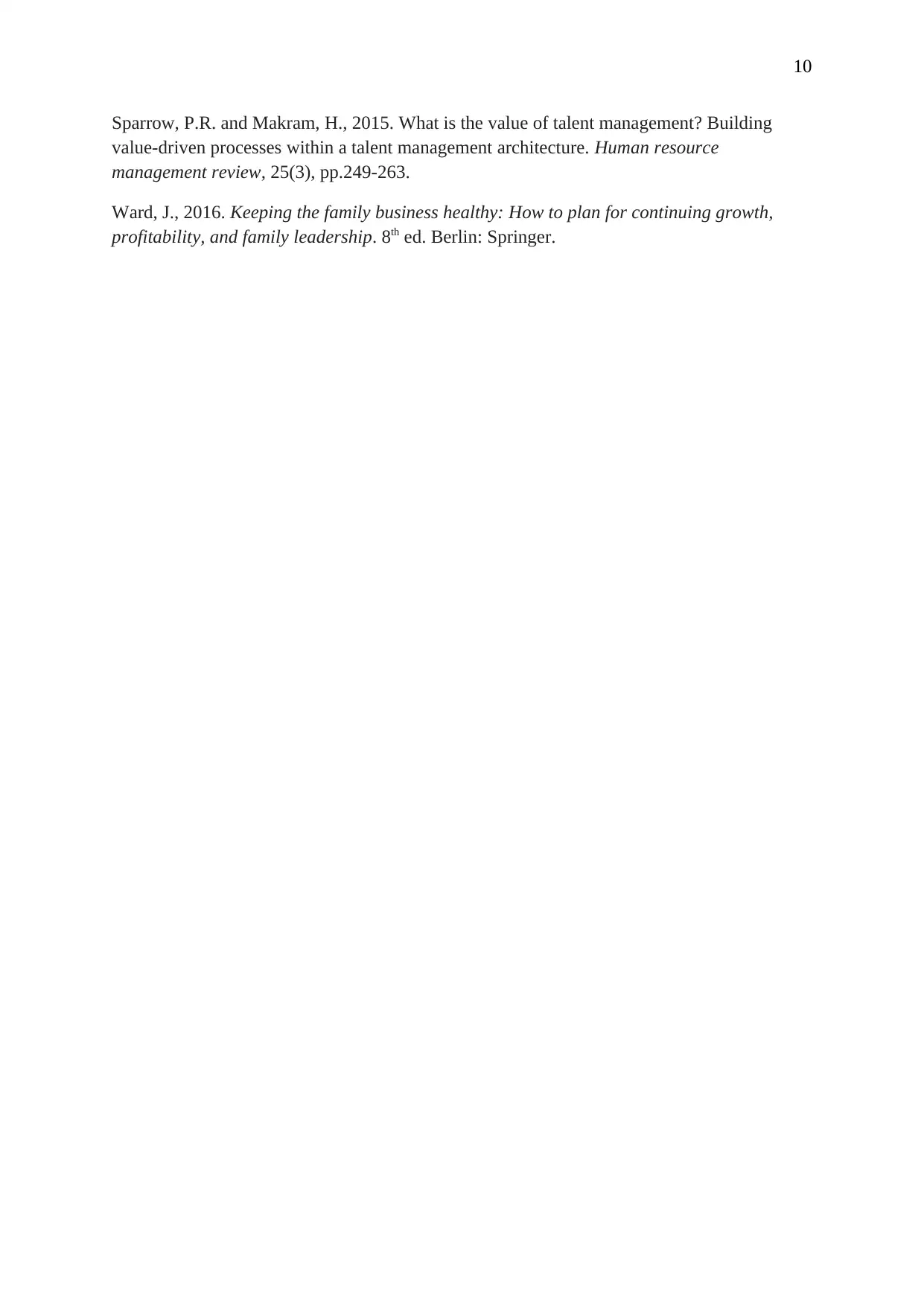
10
Sparrow, P.R. and Makram, H., 2015. What is the value of talent management? Building
value-driven processes within a talent management architecture. Human resource
management review, 25(3), pp.249-263.
Ward, J., 2016. Keeping the family business healthy: How to plan for continuing growth,
profitability, and family leadership. 8th ed. Berlin: Springer.
Sparrow, P.R. and Makram, H., 2015. What is the value of talent management? Building
value-driven processes within a talent management architecture. Human resource
management review, 25(3), pp.249-263.
Ward, J., 2016. Keeping the family business healthy: How to plan for continuing growth,
profitability, and family leadership. 8th ed. Berlin: Springer.
Paraphrase This Document
Need a fresh take? Get an instant paraphrase of this document with our AI Paraphraser
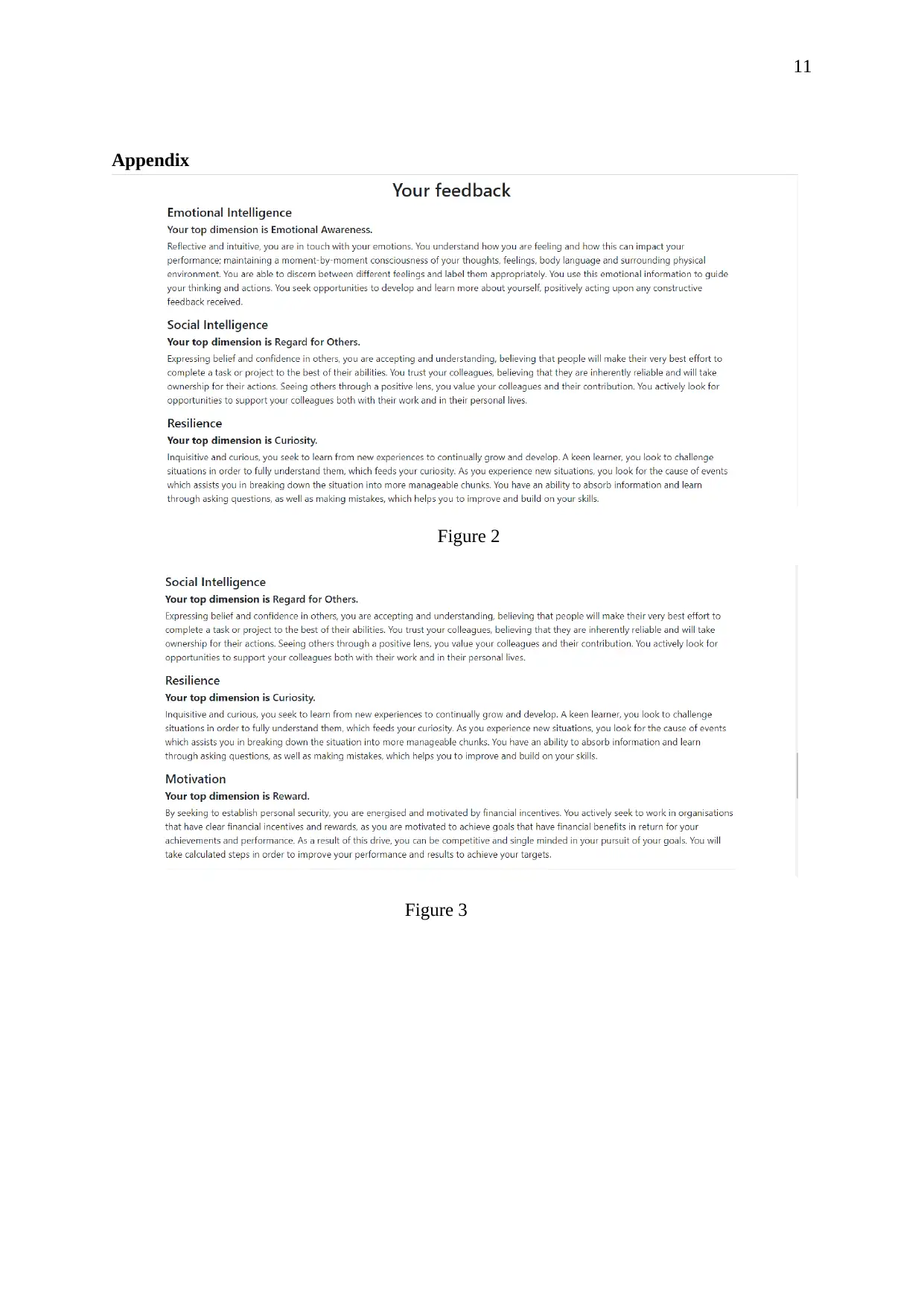
11
Appendix
Figure 2
Figure 3
Appendix
Figure 2
Figure 3
1 out of 11
Related Documents
Your All-in-One AI-Powered Toolkit for Academic Success.
+13062052269
info@desklib.com
Available 24*7 on WhatsApp / Email
![[object Object]](/_next/static/media/star-bottom.7253800d.svg)
Unlock your academic potential
Copyright © 2020–2025 A2Z Services. All Rights Reserved. Developed and managed by ZUCOL.




